STEWART VALLEY FOSSIL INSECTS
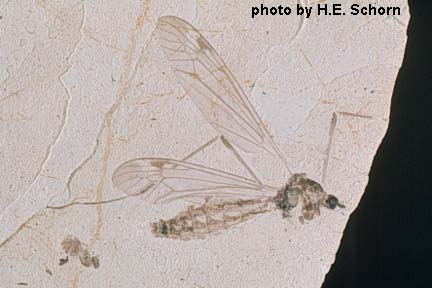
As in the rest
of the Great Basin, mountain building began in the area of the Stewart
Valley some 16 million years before the present, in the Miocene Epoch
of the Cenozoic. In an area of less than 50 square miles, the rocks
in this valley record a complex history of volcanic, fluvial, and lacustrine
environments. These environments coexisted, or alternately replaced
one another, as they responded to the ever-changing physical conditions
dictated largely by the tectonic events of the region. The life of these
times, as it interacted with the changing physical setting, is preserved
as a fossil record of these same changes. Although this physical and
biological record is but a small part of the Earth's history, the wide
variety of physical settings in such a small area, coupled with the
very diverse fossil assemblages, sets Stewart Valley apart as one of
the truly unique terrestrial fossil areas of the world. No other known
Miocene area in North America has such an excellently preserved and
diverse terrestrial record (Savage and Russell, 1983).
The fossils which
have been found in Stewart Valley range from large mammals (such as
horses, camels, rhinoceros, oreodont, and mastodonts) to small mammals,
fish, an abundance of plant species including some tree trunks and stumps,
freshwater snails and clams, and the greatest insect fossil find since
the Florissant, which it may surpass.
|
|
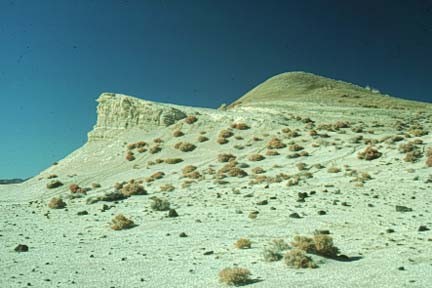
|
The insects,
for which fossil evidence exists from the Upper Carboniferous (360 -
400 million years before present) (Kukalova-Peck, 1987) potentially
offer the greatest amount of data for interpretative studies of paleoecology,
because of their great diversity and enormous number of species. Because
their occurrence as an adequate sample of well-preserved fossils is
very rare, they are hardly utilized in this respect. However, because
of the probability of its yielding tens of thousands of specimens, Stewart
Valley may be uniquely capable of supporting detailed paleoecologic
studies of the Middle Miocene, when coupled with the extensive fossil
representation of other terrestrial biota.
STEWART VALLEY DURING THE MIOCENE EPOCH
Following extrusion of the hornblende andesitic lavas of the lower
part of the Gilbert Andesite, the landscape was a gently rolling, irregular
surface for some distance around the present area, and shallow lakes
or ponds developed in which leaves of the Fingerrock Flora were preserved
in the accumulating muds.
Regional faulting and warping were initiated about this time (16 myBP)
and began to delineate the various graben-horst relationships in this
part of Nevada. Associated with this tectonic activity was the eruption
of brecciated dacite flows.
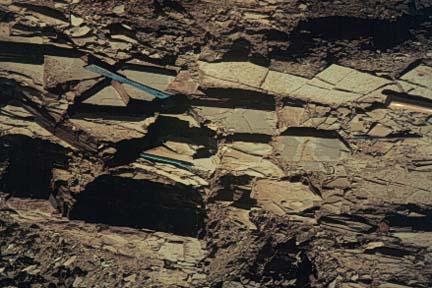
Faulting and warping of this area contemporaneously with the eruption
of the brecciated dacite flows produced a northwest-southeast drainage
system into the Stewart Valley area. Continued faulting and rifting formed
the depression in which sedimentary rocks of Units S-1 to 4 and G-1 to
3 accumulated. The basal Unit S-1 began to form some 14 - 15 myBP, and
is unconformable with the dacite breccias. The entire sedimentary record
of the earlier part of Unit S-1 indicates a time when drainage was being
interrupted and small lakes coexisted with fluvial conditions. Anastomosing
of smaller lakes and ponds brought about the formation of Stewart Valley
Lake.
During the maximum extent of the lake (Units S-2 to 4) much finer material
was brought into the lake and distributed quite uniformly. In the deeper
part of the lake only thin layers of mud accumulated. These muds (the
"paper shales" of Unit S-2) empirically indicate two features: 1) Litte
or no coarse-grained material was supplied to this part of the basin.,
2) There were no bottom-dwelling organisms or currents to disturb the
laminated (thinly bedded) sediments once they were deposited.
The undisturbed laminae, containing complete leaves, fully intact insects,
a few feathers, and articulated fish skeletons indicate a lack of scavenging
and burrowing bottom dwellers, and suggest that the lake was chemically
stratified, and the lower depths were a reducing environment, which greatly
retarded the processes of decay and promoted fossilization.
Examination of polished sections of the more silicified parts of the
paper shale sequence indicate deposition of couplets in an anerobic environment.
Presence of silicified fine-grained laminae may be 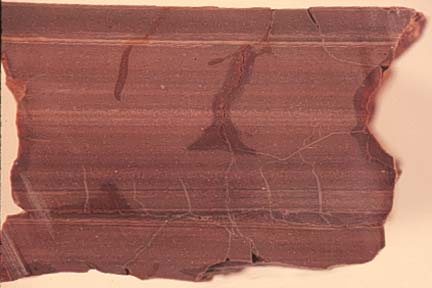 directly observed in section.
In all counts made thus far, laminae number between 110 and 120 per centimeter,
with an average of 116. The alternation of light and darker laminae (also
containing, presumably, an allochtonous clay fraction) are interpreted
as varves in the broader (non-glacial) sense, as glaciers are not involved.
Different water viscosities would, however, be expected between winter
and summer, and could account for the development of laminae, reflecting
the difference in seasonal depositions in even a warm temperate area,
such as proposed for Stewart Valley in the Miocene. Lewis (1977) has proposed
mechanisms of formation for these lacustrine varves.
directly observed in section.
In all counts made thus far, laminae number between 110 and 120 per centimeter,
with an average of 116. The alternation of light and darker laminae (also
containing, presumably, an allochtonous clay fraction) are interpreted
as varves in the broader (non-glacial) sense, as glaciers are not involved.
Different water viscosities would, however, be expected between winter
and summer, and could account for the development of laminae, reflecting
the difference in seasonal depositions in even a warm temperate area,
such as proposed for Stewart Valley in the Miocene. Lewis (1977) has proposed
mechanisms of formation for these lacustrine varves.
During the time of its maximum extent, Stewart Valley Lake was probably
about 4 to 5 miles wide, east to west, and 8 to 10 miles long. This period
coincides with a time of tectonic quiescence. The shales of Unit S-2 that
formed in the deeper part of the lake were replaced toward the lake margins,
and in the deeper parts during times of greater sediment influx, by massive-bedded
shales and siltstones. The steady increase of these fine to medium-grained
clastics ended deposition of the laminated shales of Unit S-2. The massively
bedded nature of the mudstones of Unit S-3 indicate fairly rapid deposition,
followed in turn by a period of slightly slower accumulation of the diatomaceous
mudstones of Unit S-4. A volcanic mudflow (top of Unit S-3) and air fall
ashes (Unit S-4) record an increase of pyroclastics that became much more
common in the Granny Goose Member.
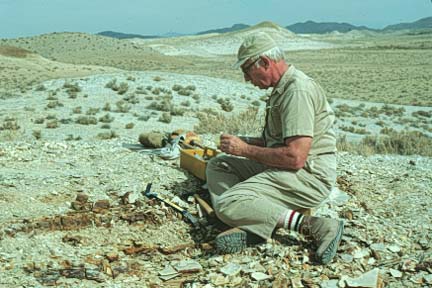
Filling of the basin, and renewed faulting in the area ended the predominately
lacustrine deposition and initiated the predominately fluvial sedimentation
of Units G 1-3. The thin pebble conglomerates and cross-bedded sandstones
lower in Unit G-1 are gradually replaced by predominately fine-grained
reworked or primary volcanic material of Units G-2 and 3. Fossil mammals
are commonly found associated with point bar sediments in Unit G-3.
The tectonic and depositional history indicate that starting about
15 myBP, the graben-horst structure was initiated, while sedimentary
accumulation began in the basin about 15 myPB. The initial fluvial conditions
were quickly followed by lacustrine deposition of the Savage Canyon
Member, Units S-1 to S-4. Renewed uplift and an increased supply of
primary and reworked volcanic debris ended the lacustrine environment
and generally filled the basin with alluvial deposits of the Granny
Goose Member, Units G-1 to G-3. Continued rifting and faulting, though
intermittent, produced the major structural features of the area and
largely controlled the land forms, with subsequent modification by weathering
and erosion.
At the present time, The Entomology Department of the California Academy
of Sciences has about 731 insect fossils representing about 11 orders
and 70 families from the Stewart Valley fossil beds. They are currently
being processed, after which the pertinent data will be entered into
a database and made available to the public through this webpage.

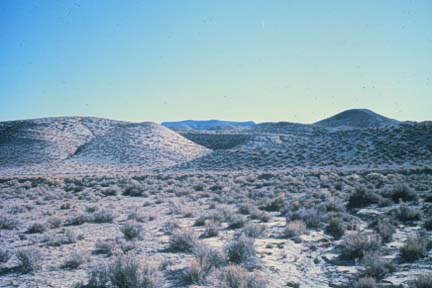


 directly observed in section.
In all counts made thus far, laminae number between 110 and 120 per centimeter,
with an average of 116. The alternation of light and darker laminae (also
containing, presumably, an allochtonous clay fraction) are interpreted
as varves in the broader (non-glacial) sense, as glaciers are not involved.
Different water viscosities would, however, be expected between winter
and summer, and could account for the development of laminae, reflecting
the difference in seasonal depositions in even a warm temperate area,
such as proposed for Stewart Valley in the Miocene. Lewis (1977) has proposed
mechanisms of formation for these lacustrine varves.
directly observed in section.
In all counts made thus far, laminae number between 110 and 120 per centimeter,
with an average of 116. The alternation of light and darker laminae (also
containing, presumably, an allochtonous clay fraction) are interpreted
as varves in the broader (non-glacial) sense, as glaciers are not involved.
Different water viscosities would, however, be expected between winter
and summer, and could account for the development of laminae, reflecting
the difference in seasonal depositions in even a warm temperate area,
such as proposed for Stewart Valley in the Miocene. Lewis (1977) has proposed
mechanisms of formation for these lacustrine varves. 